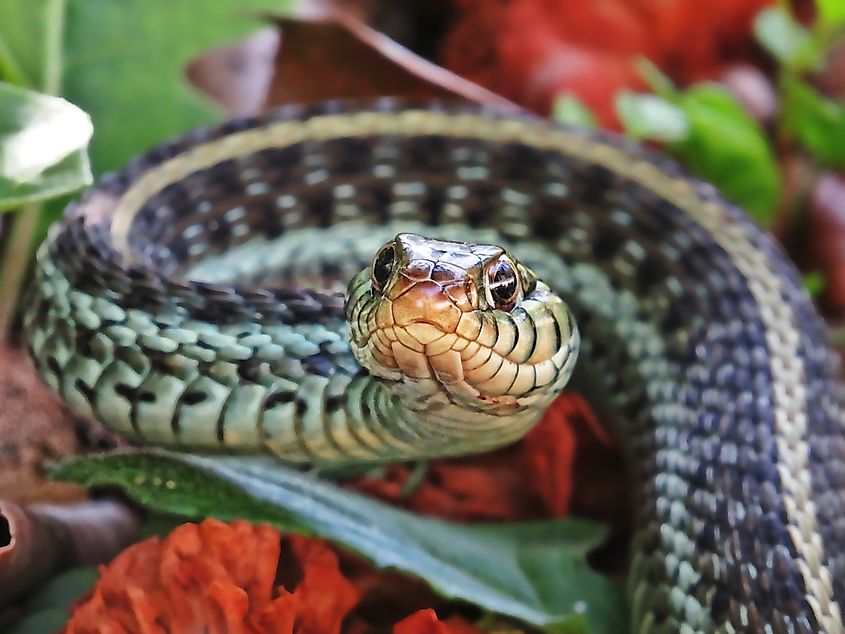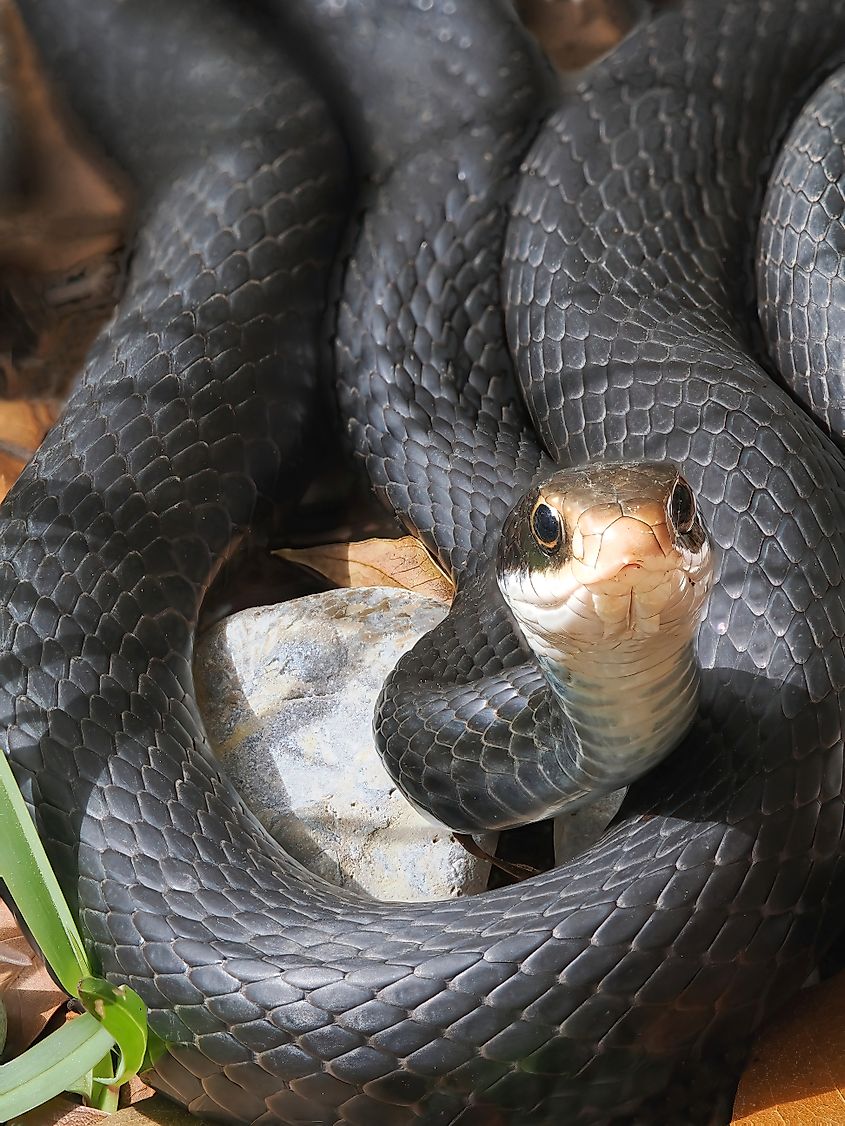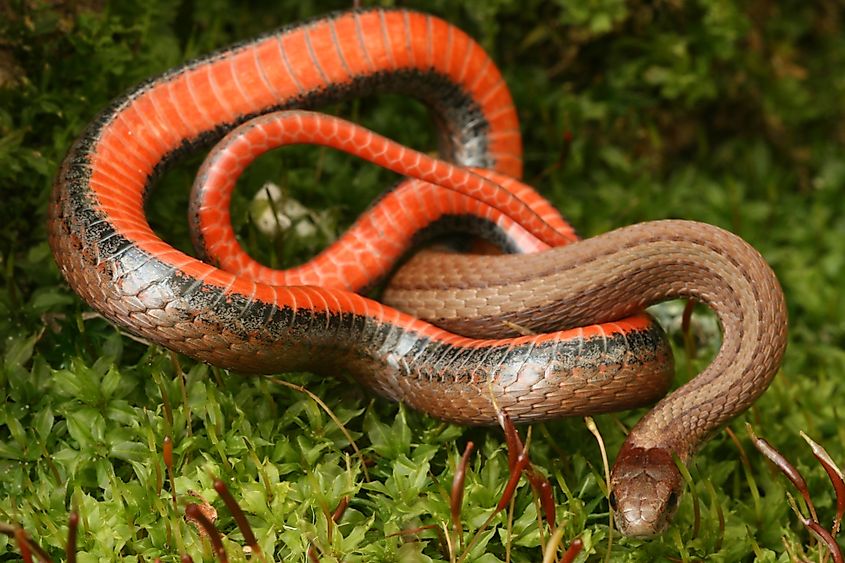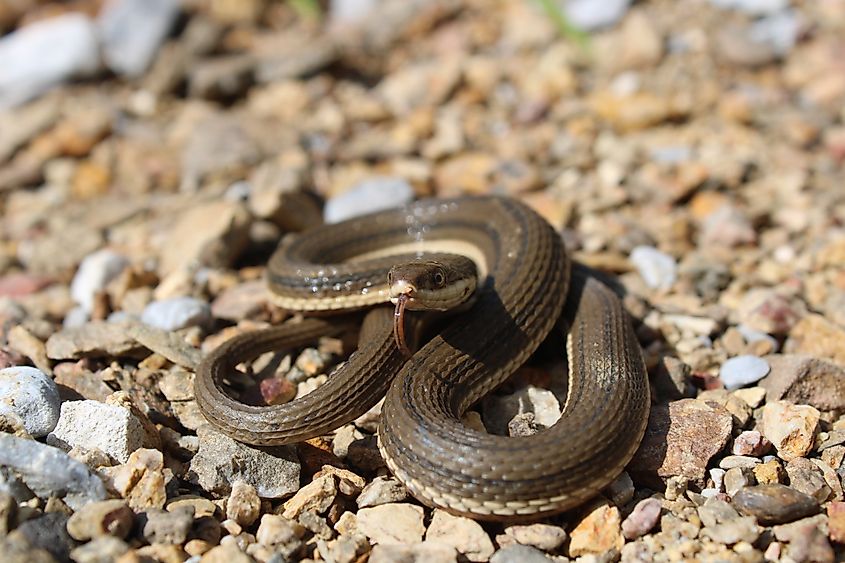
The Most Snake Infested Lakes in Connecticut
Connecticut offers no shortage of natural wonders and beautiful bodies of water. Though snake-infested may conjure images of perilous encounters, it highlights the state’s rich biodiversity and diverse ecosystem. No lake in Connecticut is ‘overrun’ with snakes, but you can stumble across one while enjoying your time outdoors. From the copperhead and hognose snake to the smooth green and milk snake, here are some of Connecticut’s most snake-populated lakes and scaley friends to look out for.
Lake Zoar

In southwestern Connecticut, you’ll find Lake Zoar, which has about 909 acres of stunning landscapes that blend natural beauty and water recreation. Formed in 1919 by the Stevenson Dam, this lake’s history is tied to the development of hydroelectric power, a renewable energy source using the kinetic energy of flowing water to generate electricity.
The shores of Lake Zoar and its lush woodlands are ideal habitats for aquatic and land snakes such as the northern water snake, eastern garter snake, and eastern rat snake.

The northern water snake (nerodia sipedon) basking on rocks or swimming near the shore. It can grow up to 4 feet long and is tan, grey, or brown with dark crossbands. Feeding primarily on fish and amphibians, this aquatic snake prefers lakes and wetlands as an ideal habitat. Being non-venomous, this snake is not dangerous to humans but can bite if they feel threatened.

The eastern garter snake (thamnophis sirtalis sirtalis) may be found throughout the woodlands surrounding this lake. This snake can grow 3 to 4 feet long and is known for its distinctive stripes. This snake is highly adaptable, feeding on amphibians, earthworms, and insects. Non-venomous, this snake is harmless to humans. However, if they feel threatened or cornered, they may bite.

The eastern rat snake (pantherophis alleghaniensis) is large, growing over 8 feet long. Black, grey, brown, or yellow, this snake features blotches or stripes with a light-colored underbelly. Being excellent climbers, you may find this snake on land or overhead in the trees, feeding on birds, eggs, and rodents. Shy and elusive, these snakes prefer to avoid human contact and will freeze if encountered. These non-venomous snakes may emit a foul odor when threatened and in rare cases, charge at predators.
Encountering one of these snakes can be thrilling and terrifying. Typically non-aggressive, they pose little threat to humans. Observe them from a distance and do not provoke them. Appreciate the crucial role these snakes play in maintaining ecological balance and enjoy your time outdoors safely.
Lake Lillinonah

Tucked away in western Connecticut, Lake Lillinonah was created in 1955 by the construction of the Shepaug Dam on the Housatonic River. It covers approximately 1,900 acres, making it the second-largest lake in Connecticut. Characterized by rolling hills, forests, and rocky shorelines, its name honors the Native American princess Lillinonah.

The ring-necked snake (diadophis punctatus) earned its name due to the distinctive yellow, orange, or cream ring pattern around its neck. Small and slender, these black or grey snakes are typically 10 to 15 inches long. Feeding on salamanders, frogs, and insects, this snake can be found under logs and rocks. They are mildly venomous, their bite feeling similar to a bee sting. However, these snakes are docile and generally don’t attack humans.

Often found in the rocky outcrops and forests around lakes, the eastern milk snake (lampropeltis triangulum triangulum) can grow over 4 feet long. Gray or tan, these snakes may display red, brown, or copper spots on their backs, making them easily identifiable. They prey on small mammals, birds, and eggs. Being non-venomous, these snakes pose no threat to humans.

Another snake you may find while enjoying Connecticut’s lakes is the copperhead. Copperheads (agkistrodon contortrix) have a robust body, growing over 3 feet. Recognizable by their iconic copper-colored head, their bodies are marked with tan and brown hourglass-shaped bands. Feeding on mice, voles, birds, amphibians, and insects, you are likely to find these snakes in Lake Lillinonah’s surrounding forests. These snakes are venomous and will bite if they feel threatened.
If you encounter a snake, do not approach it or attempt to handle it. Minimize the risks of bites by wearing protective clothing, such as sturdy boots for hiking, and staying on marked trails. While exploring Lake Lillinonah, be aware of your surroundings and respect wildlife.
Candlewood Lake

The largest lake in Connecticut, Candlewood Lake has extensive shorelines and vibrant natural beauty, making it a paradise for outdoor enthusiasts. Spanning over 8 miles across five different towns, this man-made wonder was one of the first pumped-storage reservoirs in the United States. The creation of the lake involved flooding a valley of farms and communities, and the ruins can still be explored by divers today.

Small and slender, the smooth green snake (opheodrys vernalis) is known for its vibrant green color, providing excellent camouflage in Candlewood Lake's rolling hills and grasslands. Feeding on insects and spiders, these snakes are non-venomous and pose no threat to humans.

DeKay’s brown snake (storeria dekayi) is often found in gardens and wooded areas. Small and brown, this snake is marked by light stripes on its back. They feed mostly on slugs, snails, and earthworms. These shy, non-venomous snakes like to avoid human contact by hiding under rocks, logs, and other debris.

Quick and slender, the eastern ribbon snake (thamnophis saurita) is dark in color with yellow stripes running down their body. Preferring wetlands, these snakes feed on fish, frogs, and tadpoles. Like most of the other snakes in this list, the eastern ribbon snake is non-venomous and not aggressive, posing no harm to humans.
Snakes play a vital role in controlling insect and rodent populations. While exploring Candlewood Lake, it’s important to be on the lookout for snakes. If you encounter one, give them space and avoid handling them. With caution, you can appreciate your time at the lake even more.
Lake Waramaug

Known for its scenic beauty, Lake Waramaug is nestled in a valley surrounded by rolling hills and opulent forests. Formed by glacial activity, this lake has long been cherished by locals and visitors alike. It became popular for summer cottages and resorts in the 19th and 20th centuries, many still dotting the shoreline today.

The hognose snake (heterodon platirhinos) is known for its upturned snout and typically grows between 20 and 40 inches long. It comes in various colors such as yellow, tan, olive, brown, or grey, and has irregular blotches on its back with smaller blotches on its sides. These snakes are typically found in sandy, loose soil and feed on amphibians. When threatened, hognose snakes may hiss, flatten their necks, or play dead as part of their dramatic defense displays. However, it's important to note that they are not venomous and pose no threat to humans.

Fast-moving and slender, the eastern black racer (Coluber constrictor) is solid black with smooth scales and large eyes. It can grow up to 5 feet and prey on rodents, frogs, and insects. These slender snakes can be found in open areas around Lake Waramaug. They are not venomous and rely on their speed to escape predators when threatened.

Found in moist woodlands, the redbelly snake (Storeria occipitomaculata) is small and secretive. Its body is gray or brown, contrasting sharply with its bright red belly. Feeding on slugs, snails, and insects, this non-aggressive snake prefers to retreat when feeling threatened. It poses little harm to humans; however, it may bite as a last resort.
Snakes found at Lake Waramaug are not aggressive and pose little threat to people. They play an important role in the ecosystem and are vital to the lake’s biodiversity. Remain wary of your surroundings and respect wildlife while enjoying all Lake Waramaug has to offer.
Bantam Lake

Located in scenic Litchfield County, Bantam Lake is the largest natural lake in Connecticut. Formed by glacial activity, this lake was originally inhabited by Native American tribes. In the 19th century, it became a popular summer retreat, attracting visitors to this day. Efforts to preserve the lake and its surrounding land resulted in a pristine habitat for wildlife and visitors alike.

The queen snake (regina septemvittata) is a slender, aquatic snake found in clean, rocky streams and lakeshores around Bantam Lake. Its gray or brown body hosts yellow stripes, growing up to 3 feet long. These fish like to feed on freshly molted crayfish. They are non-venomous and non-aggressive, making them no threat to people.

Highly adaptable, the common garter snake can be found near lakes, forests, meadows, and wetlands. Its dark body features distinctive yellow stripes, growing up to 3 feet long. They feast on amphibians, earthworms, and small fish. Generally shy and harmless, these snakes can be aggressive if provoked and may bite when threatened.

Large and venomous, the timber rattlesnake is nothing to be trifled with. Its heavy body hosts a pattern of dark crossbands on yellow, brow, or gray scales, growing up to 5 feet long. Preferring forests, rocky outcrops, and hillsides of Bantam Lake, they help control the rodent population by feeding on mice, rats, and squirrels. These snakes are shy and will avoid human contact. However, if you encounter one of these snakes and hear its iconic rattle, know it feels threatened and may strike.
Ecological balance requires snakes. Though most of them are harmless and will avoid you, it’s important to treat their habitat with respect. If you encounter a venomous snake such as the timber rattlesnake, give it space and do not approach it. Enjoy your time on Bantam Lake while respecting its vast biodiversity.
Pachaug Pond
Though not a lake, this large pond in eastern Connecticut hosts wetlands and forested areas, offering a scenic environment for visitors and wildlife. Enhanced by a dam to regulate water levels, this natural pond is part of Pachaug State Forests, spanning over 27 thousand acres, making it Connecticut’s largest state forest. Historically inhabited by Native Americans, the area became a site for mills and other industries during the colonial period. The diverse ecosystem of Pachaug Pond supports a variety of snakes, including the eastern smooth earth snake, eastern worm snake, and northern brown snake.

The eastern smooth earth snake is known for its red-brown or gray body and tiny bodies, growing up to 10 inches long. They may have tiny dark flecks on their bodies, with a small head and pointed snout. Feeding on insects and earthworms, these non-venomous snakes prefer the dense forest areas surrounding Pachaug Pond. Due to their secretive nature, eastern smooth earth snakes are rarely seen and pose little threat to humans.

The eastern worm snake is a small, burrowing snake with a smooth, shiny, brown body and a pinkish belly. It looks similar to a worm and can grow up to 1 foot long. These snakes prefer loose, moist soil and can be found under logs and stones, where they feed on earthworms and insects. They are non-venomous, harmless to people, and tend to be secretive in nature.

The northern brown snake also known as the Dekay’s brown snake, having similar brown bodies with faint spots. Found in wetlands near the pond, these snakes feed on slugs, snails, and insects. Being elusive, these non-venomous snakes are rarely seen.
Bumping into a snake can be scary. While exploring the area, it is important to observe these snakes from a safe distance and appreciate their contribution to the natural environment. With a respectful approach, you can enjoy the diverse wildlife that makes Pachaug Pond a vibrant and ecologically rich destination.
Squantz Pond

Squantz Pond in Southwest Connecticut
Part of Squantz Pond State Park, this area is nestled in western Connecticut. Originally part of a larger body of water, Squantz Pond was separated from Candlewood Lake by the construction of a hydroelectric dam. Named after the Native American Sqauntz tribe, this pond is home to a variety of flora and fauna with surrounding forests and hills. Rich in biodiversity, Squantz Pond provides a home for several snake species such as the brown water snake, eastern kingsnake, and eastern fox snake.

The common water snake has stout, light brown or tan bodies with dark brown, square-shaped blotches along its back and can grow over 5 feet long. It uses its brilliant swimming ability to hunt for fish and amphibians. These snakes can be found in or around the water, and they prefer areas with abundant vegetation and cover. Common water snakes are non-venomous and not aggressive; they retreat to the water when threatened. However, if they feel cornered, they will bite.

With a black, glossy body and white or yellow crossbands, the eastern kingsnake can grow over 4 feet long. You can find them in woodlands and fields surrounding Squantz Pond, feeding on rodents, birds, and other reptiles. These calm snakes are non-venomous and pose no threat to humans.

The eastern fox snake gets its name from its foxlike orange body and black splotches. It is a large non-venomous snake, growing to over 4 feet long. These snakes can be found near water in woodlands and fields, where they feed on small mammals, birds, and eggs. Although not aggressive, they may hiss or strike if they feel threatened.
More than just a beautiful destination, Connecticut’s lakes offer a peaceful escape, a variety of activities, and a glimpse into the wonders of biodiversity. From Lake Zoar to Bantam Lake, to Pachaug Pond, each hosts a vibrant ecosystem filled with vast biodiversity. As you travel shore to shore, enjoy peaceful waters or a hike through the woods while looking out for scaly inhabitants. Whether you're an avid herpetologist, a nature enthusiast, or simply someone looking for a unique outdoor adventure, stay informed and cautious and remember to respect wildlife and their habitat.











